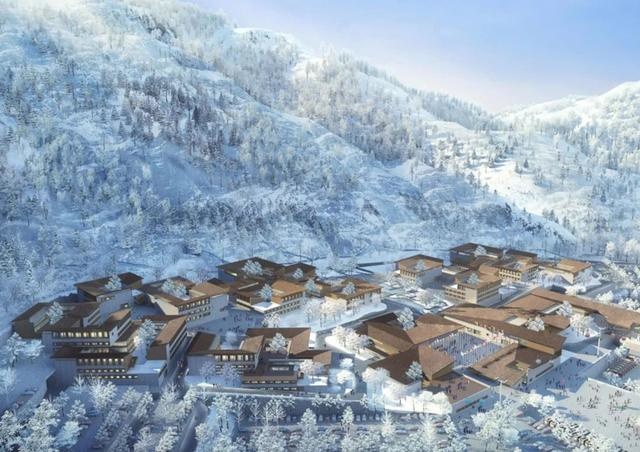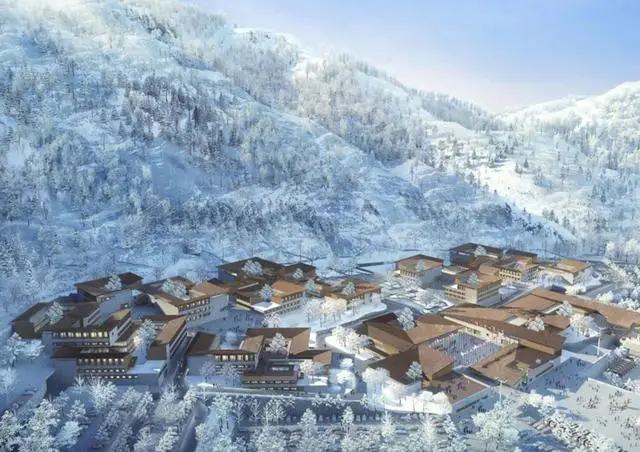By Ji Fang, People's Daily

A design sketch of the Yanqing Winter Olympics Village. Photo from Beijing News Radio
On August 20, 33 sample rooms of the Yanqing Winter Olympics Village for the 2022 Beijing Winter Olympics were unveiled, including 17 for athletes, 13 barrier-free rooms and 3 service rooms.
According to Liu Lifeng, an official with the Beijing Major Projects Construction Headquarters Office, the construction of the village will be completed by the end of this year as scheduled, and it will meet standards for receiving athletes by August 2021. The village, featuring characteristics of mountain villages in North China, highlights Chinese culture, environmental protection as well as the athlete-centered design concept. It will be open to the public as a resort hotel after the 2022 Beijing Winter Olympics.
The village, located at the foot of the Xiaohaituo Mountain, is adjacent to the National Sliding Center and a media center. It is densely filled with low-rise buildings. The semi-open hillside yards demonstrate the cultural features of Beijing's traditional quadrangles, and are perfectly integrated into the beautiful surroundings.
Liu introduced that the village is divided into 6 residential sections and 1 public sections, covering an area of 118,000 square meters. The residential sections can offer 1,430 beds for athletes and officials, while the public section will serve as an area for equipment maintenance, dining, and leisure.
To maintain the Chinese elements of these yards and maximumly protect the surrounding natural environment, the village preserved the native trees as a major landscape. Those couldn't be preserved were relocated for protection, some of which will be moved back after construction. Even the rocks excavated during construction were built into gabion walls.
It is noteworthy that the village innovatively incorporated relics protection into its planning and construction, preserving and displaying the historic site of a village built in late Qing Dynasty (1644-1911) that serves as a window that displays the ancient Chinese village culture to the world.
To offer a safe and comfortable living environment for the athletes, the village raised an athlete-centered design concept that demonstrates the sincerity of the host.
The functions of the rooms were designed to cater for the needs of the athletes. The rooms are equipped with international sockets and phone interfaces, so that they can serve the athletes from around the world. Besides, there are also Olympic telephone and TV interfaces, and the rooms are connected to the broadcasting center of the games. The athletes can watch the games at any time they want.
The village has specifically built an underground heated corridor that enables global athletes and coaches to move freely without wearing thick jackets among different sections for dining, gym training, exchanges and equipment maintenance.
To facilitate the training and competition of the athletes, the core zone of the Yanqing cluster has built a convenient transport system by which the athletes can arrive at any venue there within 30 minutes. The Yanqing cluster has 7 roads totaling 14 kilometers. Nine cableways and 5 interchange stations were constructed in the Yanqing National Alpine Skiing Centre.
Energy conservation and environmental protection are taken into consideration in all aspects of the village construction, including heating, power supply and water supply.
Located in the Yan Mountains, the village has a high demand for heating. It has an electric boiler system that stores thermal energy at night, and the system is able to cut 60 percent of energy consumption.
The Yanqing Winter Olympics Village is also a "sponge village" that recycles rainfalls with sunken greenbelts and storage ponds. All the domestic sewage generated during the games will be purified and reused.
Green and clean electricity generated by wind and solar energy from Zhangjiakou has now been connected to the Yanqing cluster. According to the planning, the 2022 Beijing Winter Olympics will be the first Olympics in history where all venues are powered by green and renewable energy, and the Yanqing cluster will make important contribution to this goal.
According to Liu Lifeng, an official with the Beijing Major Projects Construction Headquarters Office, the construction of the village will be completed by the end of this year as scheduled, and it will meet standards for receiving athletes by August 2021. The village, featuring characteristics of mountain villages in North China, highlights Chinese culture, environmental protection as well as the athlete-centered design concept. It will be open to the public as a resort hotel after the 2022 Beijing Winter Olympics.
The village, located at the foot of the Xiaohaituo Mountain, is adjacent to the National Sliding Center and a media center. It is densely filled with low-rise buildings. The semi-open hillside yards demonstrate the cultural features of Beijing's traditional quadrangles, and are perfectly integrated into the beautiful surroundings.
Liu introduced that the village is divided into 6 residential sections and 1 public sections, covering an area of 118,000 square meters. The residential sections can offer 1,430 beds for athletes and officials, while the public section will serve as an area for equipment maintenance, dining, and leisure.
To maintain the Chinese elements of these yards and maximumly protect the surrounding natural environment, the village preserved the native trees as a major landscape. Those couldn't be preserved were relocated for protection, some of which will be moved back after construction. Even the rocks excavated during construction were built into gabion walls.
It is noteworthy that the village innovatively incorporated relics protection into its planning and construction, preserving and displaying the historic site of a village built in late Qing Dynasty (1644-1911) that serves as a window that displays the ancient Chinese village culture to the world.
To offer a safe and comfortable living environment for the athletes, the village raised an athlete-centered design concept that demonstrates the sincerity of the host.
The functions of the rooms were designed to cater for the needs of the athletes. The rooms are equipped with international sockets and phone interfaces, so that they can serve the athletes from around the world. Besides, there are also Olympic telephone and TV interfaces, and the rooms are connected to the broadcasting center of the games. The athletes can watch the games at any time they want.
The village has specifically built an underground heated corridor that enables global athletes and coaches to move freely without wearing thick jackets among different sections for dining, gym training, exchanges and equipment maintenance.
To facilitate the training and competition of the athletes, the core zone of the Yanqing cluster has built a convenient transport system by which the athletes can arrive at any venue there within 30 minutes. The Yanqing cluster has 7 roads totaling 14 kilometers. Nine cableways and 5 interchange stations were constructed in the Yanqing National Alpine Skiing Centre.
Energy conservation and environmental protection are taken into consideration in all aspects of the village construction, including heating, power supply and water supply.
Located in the Yan Mountains, the village has a high demand for heating. It has an electric boiler system that stores thermal energy at night, and the system is able to cut 60 percent of energy consumption.
The Yanqing Winter Olympics Village is also a "sponge village" that recycles rainfalls with sunken greenbelts and storage ponds. All the domestic sewage generated during the games will be purified and reused.
Green and clean electricity generated by wind and solar energy from Zhangjiakou has now been connected to the Yanqing cluster. According to the planning, the 2022 Beijing Winter Olympics will be the first Olympics in history where all venues are powered by green and renewable energy, and the Yanqing cluster will make important contribution to this goal.
 Menu
Menu
 Sample rooms of Yanqing Winter Olympics Village unveiled
Sample rooms of Yanqing Winter Olympics Village unveiled
















